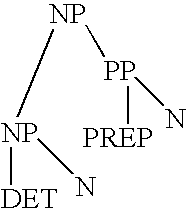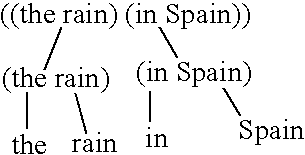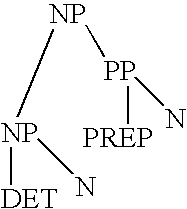Natural-language processing system using a large corpus
a processing system and corpus technology, applied in the field of natural language processing system using a large corpus, can solve the problems of unsatisfactory models, uncomplicated descriptions, and inability to compile a truly comprehensive list of all possible relationships between all possible classes of language tokens
- Summary
- Abstract
- Description
- Claims
- Application Information
AI Technical Summary
Benefits of technology
Problems solved by technology
Method used
Image
Examples
Embodiment Construction
[0071] A simple rule based system relying on a listing of possible sequences of classes for all possible classes of all possible linguistic tokens is shown schematically in FIG. 2a. In this model "The rain in Spain" is considered an acceptable string of natural language for the purposes of applications such as those described in FIG. 1b if there exists a dictionary and a set of rules such that a class can be found in the dictionary for each word in a posited string, in an order considered acceptable by the set of rules in the processor. FIG. 2b shows the style of grammatical representation used in this method, stylized here as a "vector" representation of grammar. A posited string is grammatical because there are many similar established or observed strings, the elements or the entirety of which occurs in common paradigmatic contexts (same preceding and following words). This invention provides an improvement to current vector or distributed systems based on the supposition that the...
PUM
 Login to View More
Login to View More Abstract
Description
Claims
Application Information
 Login to View More
Login to View More - R&D
- Intellectual Property
- Life Sciences
- Materials
- Tech Scout
- Unparalleled Data Quality
- Higher Quality Content
- 60% Fewer Hallucinations
Browse by: Latest US Patents, China's latest patents, Technical Efficacy Thesaurus, Application Domain, Technology Topic, Popular Technical Reports.
© 2025 PatSnap. All rights reserved.Legal|Privacy policy|Modern Slavery Act Transparency Statement|Sitemap|About US| Contact US: help@patsnap.com



